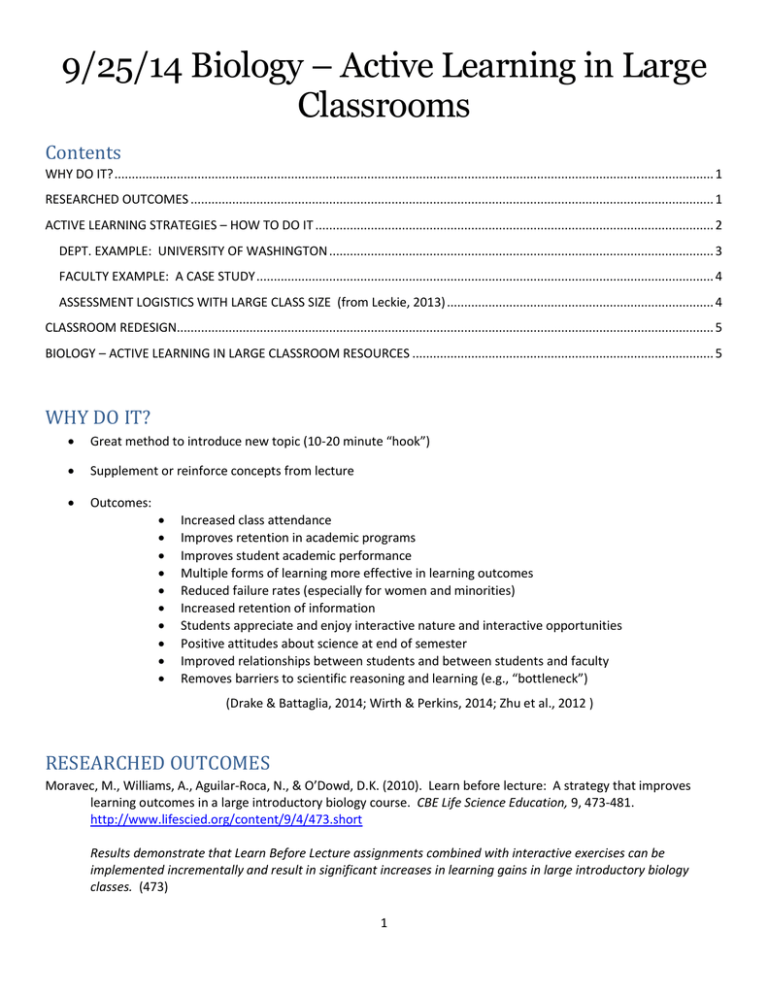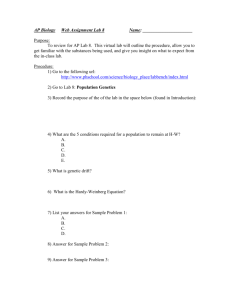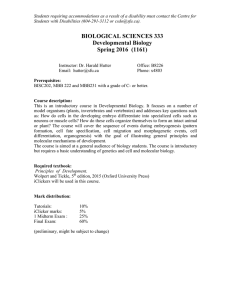9/25/14 Biology – Active Learning in Large Classrooms Contents
advertisement

9/25/14 Biology – Active Learning in Large Classrooms Contents WHY DO IT? ............................................................................................................................................................................. 1 RESEARCHED OUTCOMES ....................................................................................................................................................... 1 ACTIVE LEARNING STRATEGIES – HOW TO DO IT ................................................................................................................... 2 DEPT. EXAMPLE: UNIVERSITY OF WASHINGTON ............................................................................................................... 3 FACULTY EXAMPLE: A CASE STUDY .................................................................................................................................... 4 ASSESSMENT LOGISTICS WITH LARGE CLASS SIZE (from Leckie, 2013) ............................................................................. 4 CLASSROOM REDESIGN........................................................................................................................................................... 5 BIOLOGY – ACTIVE LEARNING IN LARGE CLASSROOM RESOURCES ....................................................................................... 5 WHY DO IT? Great method to introduce new topic (10-20 minute “hook”) Supplement or reinforce concepts from lecture Outcomes: Increased class attendance Improves retention in academic programs Improves student academic performance Multiple forms of learning more effective in learning outcomes Reduced failure rates (especially for women and minorities) Increased retention of information Students appreciate and enjoy interactive nature and interactive opportunities Positive attitudes about science at end of semester Improved relationships between students and between students and faculty Removes barriers to scientific reasoning and learning (e.g., “bottleneck”) (Drake & Battaglia, 2014; Wirth & Perkins, 2014; Zhu et al., 2012 ) RESEARCHED OUTCOMES Moravec, M., Williams, A., Aguilar-Roca, N., & O’Dowd, D.K. (2010). Learn before lecture: A strategy that improves learning outcomes in a large introductory biology course. CBE Life Science Education, 9, 473-481. http://www.lifescied.org/content/9/4/473.short Results demonstrate that Learn Before Lecture assignments combined with interactive exercises can be implemented incrementally and result in significant increases in learning gains in large introductory biology classes. (473) 1 Williams, A.E., Aguilar-Roca, N.M., Tsai, M., Wong, M., Moravec Beaupre, M., O’Dowd, D.K. (2011). Assessment of learning gains associated with independent exam analysis in introductory biology. CRE Life Sciences Education, 10, 346-356. http://www.lifescied.org/content/10/4/346.full.pdf+html Our data suggest that this easy-to-implement exercise will be useful in large-enrollment classes to help students develop self-regulated learning skill. (346) Smith, M.K., Wood, W.B., Adams, W.K., Wieman, C., Knight, J.K., Guild, N. & Su, T.T. (2009). Why peer discussion improves student performance on in-class concept questions. Science, 323, 122-124. http://www.colorado.edu/sei/documents/EOY/ASCB08Poster2.pdf When students answer an in-class conceptual question individually using clickers, discuss it with their neighbors, and then re-vote on the same question, the percentage of correct answers typically increases. This outcome could result from gains in understanding during discussion, or simply from peer influence of knowledgeable students on their neighbors. To distinguish between these alternatives in an undergraduate genetics course, we followed the above exercise with a second, similar (isomorphic) question on the same concept that students answered individually. Our results indicate that peer discussion enhances understanding, even when none of the students in a discussion group originally knows the correct answer. (122) ACTIVE LEARNING STRATEGIES – HOW TO DO IT Aesthetic Presentations Students are encouraged to think about representing their knowledge of the course content in an alternative manner Case Method Students are presented a problem based on real-world situations, and are challenged to apply course knowledge to analyze the issues and formulate solutions Clickers Student response system using wireless handheld device Collaborative Learning Strategies Jigsaw: Students work in small groups and each group member assigned to become an expert on a certain unit of study. “Experts” from different groups meet/discuss, then return to original group and teach topic to group mates. Think-Pair-Share: Students LISTEN while a question is posed, THINK of a response, PAIR with a neighbor to discuss responses, and SHARE their responses with the whole class. Send-A-Problem: Solve a problem as a group; pass the problem and solution to another group who does the same; the final group evaluates the solutions Concept Mapping Learners construct a visual map to illustrate conceptual connections and inter-relationships among concepts. Debates Students engage in structured academic controversies Interactive Discussion Craft questions likely to elicit student responses, encouraging responses from multiple perspectives Minute Paper Students to write for one minute on a given topic/prompt to summarize key points and highlights from class Muddiest Point Ask students to write a quick response to the question: What was the muddiest point today in the lecture, discussion, etc.? Note Check Ask students to partner with someone nearby and compare their notes, working together to fill gaps in their understanding of information One Sentence Summary Students are asked to synthesize notes into one sentence: “Who does what to whom, when, where, how, and why?” 2 Panel Discussions Classroom-based panel discussion, usually requires 3-5 prepared students to serve as the 'experts' on a given topic Problem-Based Learning The case method, except that course material alone cannot provide solutions to the problem. Students work in groups to conduct outside research to find solutions. Question and Answer Pairs Students read assignment before class and compose questions. In class, students pair up and take turns posing and responding to questions Role plays/Simulations Promotes real world application of theory. Explanation of the topic by the instructor, student preparation for involvement in activity, the actual role-play activity, and the discussion or debriefing on the role-play Send-A-Problem Solve problem as a group; pass problem and solution to another group who does the same; final group evaluates the solutions Service Learning Kent State University Office of Experiential Education and Civic Engagement work with faculty to incorporate civic engagement into the course curriculum Team-based Learning Students spend the bulk of class time in the application of course concepts to problem-solving. Teams of 5-7 students are permanent and work together all semester Teaching with Data Students use real or simulated data to build quantitative literacy What’s the Principle? Provide students with a few problems and ask them to discuss and decide the principle that best applies to each problem DEPT. EXAMPLE: UNIVERSITY OF WASHINGTON Popular Biology “Lecture” Courses Ditch the Lectures http://www.artsci.washington.edu/newsletter/Spotlight/2014/Biology_ActiveLearning.asp “The most inspiring comment I’ve ever gotten on a teaching evaluation was that I made a class of 700 feel like a class of 35.” “In Freeman’s classes, where active learning is used regularly and strategically, the success rate skyrockets to 90%. Data also show that the improvement is particularly striking among students from disadvantaged backgrounds.” Innovative Teaching in Biology Classes, Large and Small http://www.artsci.washington.edu/newsletter/april10/BiologyTeaching_print.html Bio 180 – Largest Intro to Bio course in the department Each night: Students complete required online quiz about assigned reading In class: Students sit as a group, by lab section (increased interaction; increased accountability) Instructor presents short lecture segments, each followed by in-class exercises -e.g., small group problem solving with random selection of report out; clicker assessment of concept and discussion Beginning of semester: Explain why active learning is being used; show data re more students passing - with better grades. 3 Explain your role as instructor in active learning as well as their role as a student Started with large enrollment courses, now integrating strategies across other courses in BIO dept. Awarded NSF teaching research grant to broaden faculty participation Critical mass of faculty within dept. using strategies and formed Bio Education Research Group w weekly meetings FACULTY EXAMPLE: A CASE STUDY Langley, D. & Guzey, S.S. (2014). Conducting an introductory biology course in an active learning classroom: A case Study of an experienced faculty member. New Directions for Teaching and Learning, 137, 71-76. http://onlinelibrary.wiley.com/doi/10.1002/tl.20087/pdf Students spend much of their time working in collaborative teams, discussing, debating, problem solving, using three-dimensional artifacts, or running simulations on the Internet depending on the problem. For Daniel,“the most important technology in the ALCs is the round tables. Everybody can interact with everybody else.” The whiteboards are also keys to advancing and making student learning visible. As students work together to agree on answers to questions, the whiteboards “are an easy way for me to look around the room and see where everybody is at. It’s pretty low tech, but it works really well.” (73) ASSESSMENT LOGISTICS WITH LARGE CLASS SIZE (from Leckie, 2013) The following comments are based on experiences (Leckie, 2013) with the large Intro Oceanography course at UMassAmherst. We do some form of student-active learning every day in class; sometimes two activities. The students expect it. We collect many of the in-class activities that the students do, but there are many that we don't, and we don't tell them ahead of time whether something will be collected or not. These in-class activities are worth up to 20% of the final grade. For us, this is the same value as an exam; students can earn the equivalent of a 100% on an exam simply by coming to class every day and participating. This is a great incentive to get them to engage! Grading of the collected in-class activities is designed to be simple: we give 2 points for a completed activity, 1 point for an incomplete effort, and zero for nothing turned in. We don't spend much time actually evaluating the student responses because we nearly always have a classroom discussion about the activity before it is turned in. Collection of 300 pieces of paper on a regular basis can be challenging, but we do 2 things that expedite the sorting: 1) students write the first 3 letters of their last name in the upper right-hand corner of the paper (in large block letters), and 2) they place their exercise in the appropriate box (reprint box with one or more letters, "A-B", "C-D", etc.) as they exit the classroom at the end of class. Alphabetizing, grading, and entering the scores in a spreadsheet will take a Teaching Assistant only ~1 hour or so. We use these same labeled reprint boxes to return graded exercises to the students during the next class; we arrive early to class and put the graded exercises out for students to pick up before class begins. Taken from here ------------- 4 CLASSROOM REDESIGN SCALE-UP (Student-Centered Active Learning Environment with Upside-down Pedagogies) - Research-based state of the art classroom designs University of Minnesota, College of Biological Sciences - Active learning in large classrooms Kent State University Proposed Center for Teaching and Learning BIOLOGY – ACTIVE LEARNING IN LARGE CLASSROOM RESOURCES 1. Faculty-coached, In-class Problem Solving http://serc.carleton.edu/sp/library/coached_problems/index.html Examples faculty-coached, in-class problems from an introductory biology course: http://serc.carleton.edu/sp/library/coached_problems/examples.html RNA processing and northern blot technique problem Gleevec and the cell cycle problem Gene expression during development: Experimental design problem Phylogenetics problems Malnutrition, DNA replication, development, and schizophrenia homework problem 2. iBiology Scientific Teaching Series Active Learning Module 3. Connecting Concepts: Interactive Lessons in Biology Instructor Resources 4. Michigan State University Office of Faculty & Organizational Development Teaching Resources in Biology: Evolution, Genetics, Conservation and Biodiversity 5. Teaching in the Large Undergraduate STEM Classroom 5 CIRTL (Center for the Integration of Research, Teaching and Learning) Network: Active learning in the large enrollment classes Using primary literature to teach science to intro bio students Incorporating service learning into the large undergraduate classroom 6. National Center for Case Study Teaching in Science Case Collection and Teaching Resources 7. Allen, D. & Tanner, K. (2005). Infusing active learning into the large-enrollment biology class: Seven strategies, from simple to complex. Cell Biology Education, 4(4), 262-268. http://www.ncbi.nlm.nih.gov/pmc/articles/PMC1305885/ Bookending lecture with questions that focus student discussion Classroom technology (student response systems) Student presentations and projects Learning-cycle instructional models Peer-led team learning (e.g., supplemental instruction) Modeling inquiry approaches in the large class Problem-based learning and case studies 8. www.everyslide.com References Drake, E. & Battaglia, D. (2014). Teaching and Learning in Active Learning Classrooms. College of Science and Technology, Central Michigan University. Leckie R.M. (2011). Teaching Introductory Geoscience Courses in the 21st Century. Engage students with active learning strategies. http://serc.carleton.edu/NAGTWorkshops/intro/largeclasses_leckie.html Wirth, K.R. & Perkins, D. (2014). Learning to learn. http://www.macalester.edu/academics/geology/wirth/learning.pdf Zhu, C., Rehrey, G., Treadwell, B. & Johnson, C.C. (2012). Looking back to move ahead: How students learn geologic time by predicting future environmental impacts. Journal of College Science Teaching, 41(3), 54-60. 6





